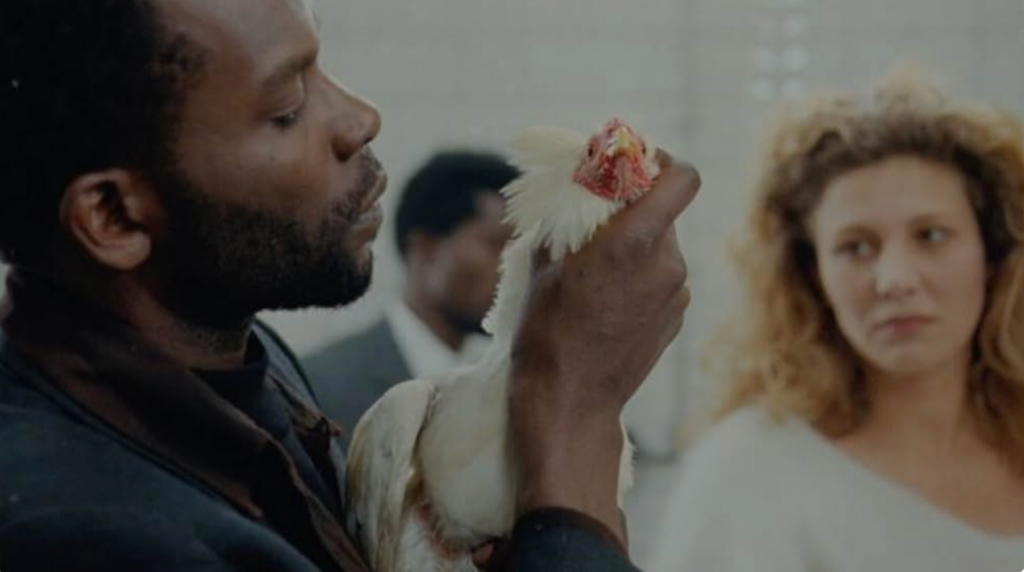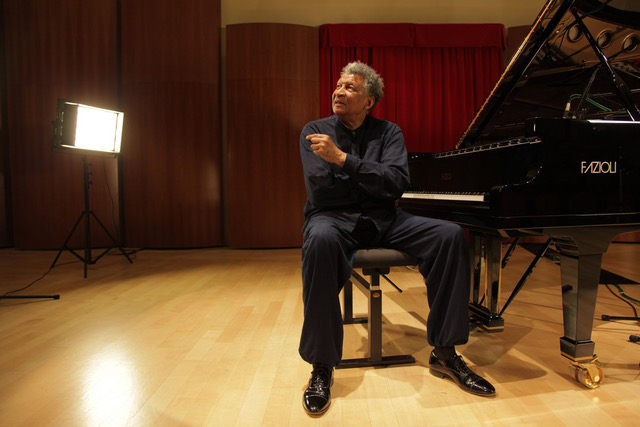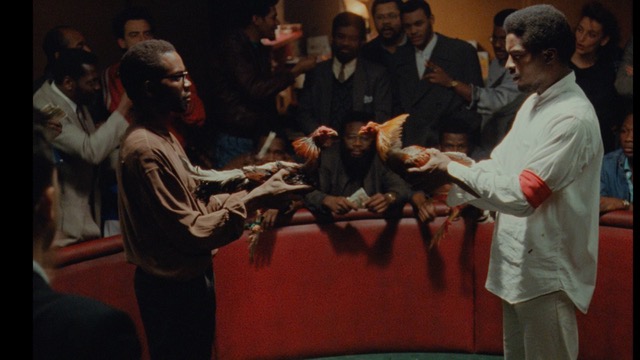| Courtney Kowalke |

Image sourced from Internet Movie Database
No Fear, No Die plays at the Trylon Cinema from Sunday, April 13th, through Tuesday, April 15th. For tickets, showtimes, and other series information, visit trylon.org.
Recently, I’ve been getting into jazz. This exploration is born of necessity: I work third shifts. I want to listen to music on the job, so I need workplace-appropriate tunes. I also get annoyed by incessant ad breaks, overly chatty DJs, and radio stations that play the same twenty songs over and over and over. Jazz88 has the least commercials and the most variety in their music selection, so jazz it is when I’m on the clock.
I was bound to run into Abdullah Ibrahim sooner or later in my journey. Ibrahim was born in 1934 and has been active in the South African music scene since 1955, marking this the seventieth year of his career. Ibrahim has recorded under the name Dollar Brand and as part of the Dollar Brand Trio, the Tuxedo Slickers, and the Jazz Epistles. He released fifty albums before I was born and twenty-two albums since then. He has collaborated with too many famous musicians for me to list, though I will highlight American bandleader John Coltrane, my on-ramp into jazz. Turn over a rock in the jazz scene, and you’ll find Abdullah Ibrahim.
Before I could discover Ibrahim during one of my nightly radio sessions, I encountered him as the composer for Claire Denis’s 1990 film No Fear, No Die (or S’en fout la mort, which more accurately translates to “Death doesn’t care”). No Fear, No Die is the second film Ibrahim scored for Denis, after her 1988 debut Chocolat. When asked by The Guardian in 2000 how she and Ibrahim started working together, Denis noted, “Abdullah Ibrahim is different [from her early collaborators]. He’s a musician I really like… [a]s he was one of the formidable, interesting musicians of the free jazz experience. When I wrote my first script, I didn’t mind his music from South Africa, as he was exiled from South Africa. I saw this music was carrying this sort of regret for a country that he doesn’t live in any more. I wrote him a letter and he answered and we collaborated on two films.”
Denis had better luck than I did—I found Ibrahim’s contact information during my research, but by the time you’re reading this, haven’t heard back from him or anyone on his team. It’s understandable since Ibrahim is currently touring, with his most recent concert taking place in Weimar, Germany, on March 30th. It’s still frustrating since I couldn’t find much in the way of interviews or quotes directly from Ibrahim regarding his work with Denis.

Image sourced from Bandcamp
Fortunately, the soundtrack to No Fear, No Die can speak for itself. Whether or not I can translate what it’s saying is another matter. I like jazz, but I’m not sure I fully ‘get’ it or can articulate what I like about it. Is labeling something as being slow a good thing or a bad thing? Do I recognize all the instruments being used? Is the melody full-bodied or mellow? What story is the song telling, and what adjectives best describe it?
My on-ramp here is yet another jazz musician, American bassist Tarus Mateen. In a 2024 interview with JazzTimes, Mateen spoke of his introduction to Ibrahim, saying, “I went to go hear Abdullah [Ibrahim] and said, ‘Oh man. What is this? This is boring!’ because I was a young, fiery man. [laughs] Just hearing Abdullah with this really subtle, almost sedentary vibe. It wasn’t until I saw him five years later that I began appreciating the meditative aspect of what he’s trying to give to the people.” I don’t know that “sedentary” is a desirable descriptor, but “subtle” and “meditative” make sense to me. I pick up what Mateen is throwing down. I can follow his lead.
Ibrahim’s score for No Fear, No Die flirts with several other styles and emotions. “Angelica” has sort of a playful cat-and-mouse vibe, with urgent, racing instrumentation. “Meditation II” is a more blues-y jazz affair, with melancholy yet assertive piano and moody horns. This is one I would imagine playing in a smoke-filled bar in a film from the 1950s. “Meditation” is a bit happier, with a clear, bright saxophone melody, but it shares “Meditation II”’s slower tempo. I also noticed some fun things with the percussion in “Meditation,” some snare trills here and there. All the numbers are intriguing without being overpowering; they do a good job underscoring No Fear, No Die, adding dynamism to scenes without distracting from them. As an album, the soundtrack is a tight, fun listen.
The specific song Mateen is describing in JazzTimes is Ibrahim’s main theme for No Fear, No Die, “Calypso Minor.” “Calypso Minor” appears several times in the film, with a “Calypso Major” variation appearing less frequently. The tune is more subdued than what I think of Calypso music as; there is no vocal melody. The bassline is mellow but driving, and I can only describe the intermittent horns as “cool.”
The tune is inarguably jazz, but drawing subtle influence from Calypso music is a clever move. No Fear, No Die is centered on Dah (Isaach De Bankolé) and Jocelyn (Alex Descas), two young men who immigrated to France. There, they organize illegal cockfights to make money. Dah hails from Benin in West Africa, and the movie follows his point of view. Jocelyn is West Indian, and despite Dah being the narrator, Jocelyn drives the film’s plot. Jocelyn has the most conflict, both internal and external. Jocelyn also shapes the soundtrack—Calypso music originated in Trinidad and Tobago, tying the film’s main theme more to Jocelyn and his culture than to any other character.
Jocelyn’s Caribbean heritage influences the music beyond Ibrahim’s compositions. During the opening credits, Dah and Jocelyn groove out to Bob Marley and Wailers’ “Buffalo Soldier.” I think the use of this song specifically is smart since it illustrates Dah and Jocelyn’s youth—they would be into a then-recent release such as “Buffalo Soldier” as opposed to the non-diegetic jazz soundtrack.
The lyrics of “Buffalo Soldier”—in which Marley talks of Black soldiers who fight for survival in a country that is hostile toward them—can also relate to Dah and Jocelyn’s role as outsiders in white Parisian society. The duo can’t walk down the street at night without being yelled at by their fellow cockfighters. Late in the film, they realize Pierre (Jean-Claude Brialy)—the man who owns the restaurant where the cockfights take place and the space where Dah and Jocelyn have been living—has been locking them in their room at night without their knowledge.
I also think the third verse of “Buffalo Soldier,” which subtly points out that a lot of Black people don’t know their family’s country of origin since they were abducted from the African continent is an interesting parallel because Jocelyn’s specific nationality is never mentioned. We know he’s from the West Indies, but not which island he grew up on.

Sourced from Film at Lincoln Center
Jocelyn is also fond of blasting “Pure Righteousness” by American emcee Lakim Shabazz while training his roosters to fight. Most of the lyrics to that song detail beliefs of The Five-Percent Nation, a Black nationalist movement influenced by the Nation of Islam. Founded in Harlem in 1964, the movement arose from Clarence 13X’s dissatisfaction with his then-current temple. He and many others felt unaccepted and were looking for a community they felt they belonged to. As with most socio-political movements, The Five-Percent Nation arose from people feeling displaced, the way Dah and Jocelyn are displaced among their white peers and far from the countries they grew up in.
As Denis mentioned earlier, Ibrahim knows the feeling of being displaced from his home country as well. Ibrahim was living in Cape Town, South Africa, during the apartheid. According to the biography on Ibrahim’s website, “After the notorious Sharpeville massacre of 1960, mixed-race bands and audiences were defying the increasingly strict apartheid laws, and jazz symbolized resistance, so the government closed a number of clubs and harassed the musicians.” After Nelson Mandela was imprisoned in 1962, Ibrahim left South Africa for Germany. Three years later, he moved to New York City. After Madela was freed in 1990, he invited Ibrahim to return to South Africa, and Ibrahim spent the next few decades splitting his time between Cape Town and NYC.
I have no frame of reference for this but I have to imagine no matter how happy Ibrahim is with his life and his career, that experience must have hurt. I imagine the pain of needing to leave your home or else risk being killed stays with you, that the trauma of being forcibly displaced lingers. To then spend your life calling multiple places home, to wonder when and where you are welcome, would get tiring.
Regardless of this emotional strain, Ibrahim has yet to tire of making and sharing music. “Since I was 16 years old, I’ve been on tour,” Ibrahim told Mario-Felix Vogt in an interview for Pianist Magazine this March. He’s booked to spend the rest of this year performing across Germany, the Czech Republic, and at the Lincoln Center in New York City. Ibrahim is on the road promoting 3, a live album released in 2023 and his seventy-second album overall. The soundtrack to No Fear, No Die is the first album of Ibrahim’s that I have listened to all the way through; I’m glad to know I have plenty more of his music to keep me company on the long nights yet to come.
Edited by Olga Tchepikova-Treon
